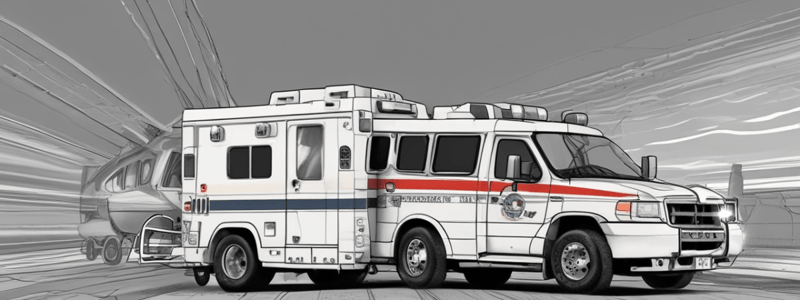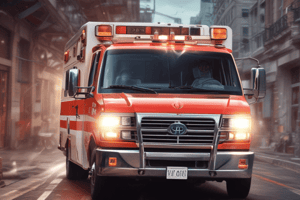Podcast
Questions and Answers
What is a primary consideration for air transport in a mass-casualty situation?
What is a primary consideration for air transport in a mass-casualty situation?
- Availability of medical personnel on site
- Potential for patient deterioration due to delays (correct)
- Availability of road transport
- Severity of injuries of all patients on site
Which of the following is an indication for air transport per SOP?
Which of the following is an indication for air transport per SOP?
- Patients with minor injuries requiring only basic life support
- All patients requiring urgent care
- Level 1 trauma center after prolonged extrication in a patient who meets criteria for level 1 Trauma Center (correct)
- Patients with no vital signs
What is the primary responsibility of scene personnel during a scene survey?
What is the primary responsibility of scene personnel during a scene survey?
- Rapidly analyzing MOI and assessing injuries (correct)
- Contacting OLMC physician for air transport authorization
- Determining the number of patients requiring air transport
- Initiating care per SOP
Who is responsible for contacting the aeromedical service closest to the incident site?
Who is responsible for contacting the aeromedical service closest to the incident site?
What is the purpose of contacting OLMC physician during a scene survey?
What is the purpose of contacting OLMC physician during a scene survey?
What happens after OLMC physician approves aeromedical transport?
What happens after OLMC physician approves aeromedical transport?
Who is responsible for communicating updated patient information to helicopter personnel?
Who is responsible for communicating updated patient information to helicopter personnel?
What is the time frame for aeromedical service to contact scene personnel to complete flight arrangements?
What is the time frame for aeromedical service to contact scene personnel to complete flight arrangements?
What is the minimum perimeter requirement for a helicopter landing zone during the day?
What is the minimum perimeter requirement for a helicopter landing zone during the day?
What is the maximum slope allowed for a helicopter landing zone?
What is the maximum slope allowed for a helicopter landing zone?
What is the minimum number of lights required to mark a helicopter landing zone at night?
What is the minimum number of lights required to mark a helicopter landing zone at night?
What is the minimum size of a landing zone required for a helicopter during the day?
What is the minimum size of a landing zone required for a helicopter during the day?
What information is NOT required to be provided to the helicopter dispatcher for flight arrangements?
What information is NOT required to be provided to the helicopter dispatcher for flight arrangements?
What should be done to the corners of the landing zone?
What should be done to the corners of the landing zone?
Which of the following is NOT a requirement for a safe helicopter landing zone?
Which of the following is NOT a requirement for a safe helicopter landing zone?
Why should bystanders be kept at least 150’ away from the landing zone?
Why should bystanders be kept at least 150’ away from the landing zone?
Which of the following is NOT a factor to consider when establishing a helicopter landing zone?
Which of the following is NOT a factor to consider when establishing a helicopter landing zone?
What should be worn during helicopter operations?
What should be worn during helicopter operations?
Why should the landing site be as smooth and flat as possible?
Why should the landing site be as smooth and flat as possible?
Why is it important to mark a helicopter landing zone for the pilot, both during the day and at night?
Why is it important to mark a helicopter landing zone for the pilot, both during the day and at night?
What should be established once the helicopter is on the ground?
What should be established once the helicopter is on the ground?
What is the primary purpose of the information provided by the requesting agency to the helicopter dispatcher?
What is the primary purpose of the information provided by the requesting agency to the helicopter dispatcher?
What should be used to secure the landing zone?
What should be used to secure the landing zone?
What should be stationed nearby during helicopter operations?
What should be stationed nearby during helicopter operations?
Under what conditions should the ground crew assist the flight crew with opening or closing helicopter doors?
Under what conditions should the ground crew assist the flight crew with opening or closing helicopter doors?
What is the maximum recommended time for ground scene operations, including patient loading, assuming the ground crew is ready to assist and no critical interventions are required?
What is the maximum recommended time for ground scene operations, including patient loading, assuming the ground crew is ready to assist and no critical interventions are required?
What is the primary objective of establishing a Helicopter Division for landing zone activities?
What is the primary objective of establishing a Helicopter Division for landing zone activities?
What specific action should the ground crew take if weather appears to be poor and a helicopter is needed for transport?
What specific action should the ground crew take if weather appears to be poor and a helicopter is needed for transport?
What is the recommended procedure for a conscious patient prior to helicopter transport?
What is the recommended procedure for a conscious patient prior to helicopter transport?
Which of the following actions should be taken before moving a patient to the helicopter?
Which of the following actions should be taken before moving a patient to the helicopter?
What is the rationale for leaving the patient's arms free and chest exposed when possible during helicopter transport?
What is the rationale for leaving the patient's arms free and chest exposed when possible during helicopter transport?
Which of the following is NOT a recommended action for ground crew members during helicopter transport?
Which of the following is NOT a recommended action for ground crew members during helicopter transport?
What is the minimum distance bystanders should be kept from the perimeter of the landing area?
What is the minimum distance bystanders should be kept from the perimeter of the landing area?
What is the recommended angle to approach a helicopter?
What is the recommended angle to approach a helicopter?
Where is the highest wind and greatest amount of flying debris produced during a helicopter landing?
Where is the highest wind and greatest amount of flying debris produced during a helicopter landing?
What should responders do if approaching a helicopter with a patient while the engines are running?
What should responders do if approaching a helicopter with a patient while the engines are running?
What should responders do if approaching a helicopter on sloped terrain?
What should responders do if approaching a helicopter on sloped terrain?
What is the minimum number of fire extinguishers that should be present during helicopter landings and takeoffs?
What is the minimum number of fire extinguishers that should be present during helicopter landings and takeoffs?
When should responders approach a helicopter?
When should responders approach a helicopter?
What is the reason for keeping all equipment below the waist when approaching a helicopter?
What is the reason for keeping all equipment below the waist when approaching a helicopter?
Flashcards are hidden until you start studying
Study Notes
Indications for Air Transport
- Patients inaccessible due to weather, disasters, or mass-casualty situations, where there is a potential for delays
- Level 1 trauma center after prolonged extrication in a patient who meets criteria for level 1 Trauma Center
- Hyperbaric center for a severely confused patient (GCS 13 or less) with suspected CO/smoke inhalation or a diver with nitrogen narcosis
- Need for access to a more distant trauma center, i.e., disaster/medium to large scale situation
Scene Personnel Responsibilities
- Perform scene survey, analyze MOI, and determine need for air transport
- Initiate care per SOP and contact OLMC physician for authorization
- Obtain and document physician on PCR
- If approved, OLMC will advise scene personnel, and aeromedical service will contact them to complete flight arrangements
Information Needed by OLMC and Helicopter Dispatcher
- Name of requesting agency, requesting person, and call back number/radio frequency
- Brief description of emergency scene
- Number of patients requiring air transport, name, and age (if available)
- Type of incident, mechanism, and/or extent of illness/injuries
- Brief description of patient injury (vital signs and pertinent medical history, if available)
- Care already performed
- Landing site location and description
- Ground contact person and radio frequency
- When the patient is to be picked up
- Special devices and personnel required to transport victims
- Ambulance transporting to and from landing site (if indicated)
- Weather conditions at scene (if adverse)
Establishing a Helicopter Landing Zone
- Follow Hoffman Estates preplanned landing sites and Northwest Community EMS System policy
- Site should have a 100-foot perimeter (150 feet at night or high winds)
- Site should be clear of trees, wires, towers, emergency vehicles, signs, or hazards
- Site should be smooth and flat as possible, with no more than a nominal (8 degree) slope
- Mark for helicopter pilot using hand signal or flare
- Ensure security, use rope, barricades, or vehicles to secure area
- Keep bystanders at least 150 feet from the perimeter of the landing area
- Request police assistance for crowd control
Approaching and Loading the Helicopter
- Approach aircraft within a 30-45 angle from the front
- Assign one assertive team member to ensure all responders stay clear of the tail rotor
- Approach and depart the helicopter from the downhill side if a sloped terrain
- Secure straps on cot over top of blanket covering the patient
- Secure all loose objects and equipment
- Allow flight crew to open and close helicopter doors
- Follow "time savers" guidelines based on Northwest Community EMS System policy
Studying That Suits You
Use AI to generate personalized quizzes and flashcards to suit your learning preferences.




